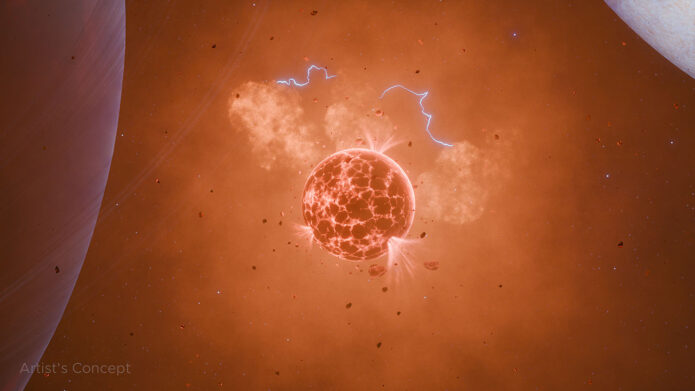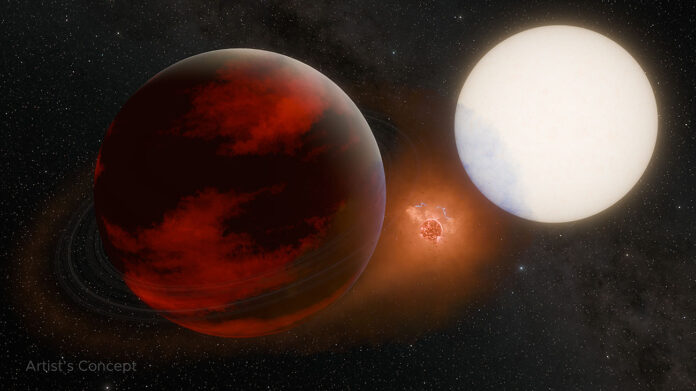 Pasadena, CA – New research done at NASA’s Jet Propulsion Laboratory reveals potential signs of a rocky, volcanic moon orbiting an exoplanet 635 light-years from Earth.
Pasadena, CA – New research done at NASA’s Jet Propulsion Laboratory reveals potential signs of a rocky, volcanic moon orbiting an exoplanet 635 light-years from Earth.
The biggest clue is a sodium cloud that the findings suggest is close to but slightly out of sync with the exoplanet, a Saturn-size gas giant named WASP-49 b, although additional research is needed to confirm the cloud’s behavior.
Within our solar system, gas emissions from Jupiter’s volcanic moon Io create a similar phenomenon.
Although no exomoons (moons of planets outside our solar system) have been confirmed, multiple candidates have been identified. It’s likely these planetary companions have gone undetected because they are too small and dim for current telescopes to detect.
The sodium cloud around WASP-49 b was first detected in 2017, catching the attention of Apurva Oza, formerly a postdoctoral researcher at NASA’s Jet Propulsion Laboratory and now a staff scientist at Caltech, which manages JPL.
Oza has spent years investigating how exomoons might be detected via their volcanic activity. For example, Io, the most volcanic body in our solar system, constantly spews sulfur dioxide, sodium, potassium, and other gases that can form vast clouds around Jupiter up to 1,000 times the giant planet’s radius. It’s possible that astronomers looking at another star system could detect a gas cloud like Io’s even if the moon itself were too small to see.
Both WASP-49 b and its star are composed mostly of hydrogen and helium, with trace amounts of sodium. Neither contains enough sodium to account for the cloud, which appears to be coming from a source that is producing roughly 220,000 pounds (100,000 kilograms) of sodium per second. Even if the star or planet could produce that much sodium, it’s unclear what mechanism could eject it into space.
Could the source be a volcanic exomoon? Oza and his colleagues set out to try to answer that question. The work immediately proved challenging because from such a great distance, the star, planet, and cloud often overlap and occupy the same tiny, faraway point in space. So the team had to watch the system over time.
A Cloud on the Move

As detailed in a new study published in the Astrophysical Journal Letters, they found several pieces of evidence that suggest the cloud is created by a separate body orbiting the planet, though additional research is needed to confirm the cloud’s behavior. For example, twice their observations indicated the cloud suddenly increased in size, as if being refueled, when it was not next to the planet.
They also observed the cloud moving faster than the planet in a way that would seem impossible unless it was being generated by another body moving independent of, and faster, than the planet.
“We think this is a really critical piece of evidence,” said Oza. “The cloud is moving in the opposite direction that physics tells us it should be going if it were part of the planet’s atmosphere.”
While these observations have intrigued the research team, they say they would need to observe the system for longer to be sure of the cloud’s orbit and structure.
A Chance of Volcanic Clouds
For part of their sleuthing, the researchers used the European Southern Observatory’s Very Large Telescope in Chile. Oza’s co-author Julia Seidel, a research fellow at the observatory, established that the cloud is located high above the planet’s atmosphere, much like the cloud of gas Io produces around Jupiter.
They also used a computer model to illustrate the exomoon scenario and compare it to the data. The exoplanet WASP-49 b orbits the star every 2.8 days with clocklike regularity, but the cloud appeared and disappeared behind the star or behind the planet at seemingly irregular intervals.
Using their model, Oza and team showed that a moon with an eight-hour orbit around the planet could explain the cloud’s motion and activity, including the way it sometimes seemed to move in front of the planet and did not seem to be associated with a particular region of the planet.
“The evidence is very compelling that something other than the planet and star are producing this cloud,” said Rosaly Lopes, a planetary geologist at JPL who co-authored the study with Oza. “Detecting an exomoon would be quite extraordinary, and because of Io, we know that a volcanic exomoon is possible.”
A Violent End
On Earth, volcanoes are driven by heat in its core left over from the planet’s formation. Io’s volcanoes, on the other hand, are driven by Jupiter’s gravity, which squeezes the moon as it gets closer to the planet then reduces its “grip” as the moon moves away. This flexing heats the small moon’s interior, leading to a process called tidal volcanism.
If WASP-49 b has a moon similar in size to Earth’s, Oza and team estimate that the rapid loss of mass combined with the squeezing from the planet’s gravity will eventually cause it to disintegrate.
“If there really is a moon there, it will have a very destructive ending,” said Oza.



